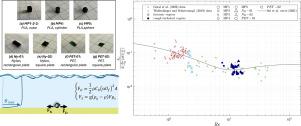波浪诱导非浮力塑料颗粒的初始运动:实验室实验
IF 4.5
2区 工程技术
Q1 ENGINEERING, CIVIL
引用次数: 0
摘要
在二维水槽中,系统地研究了不同形状和密度的9个非浮力塑料颗粒在表面波下的初始运动。在每次测试中,将10个相同的颗粒放置在床上,并且当在每个波周期中至少有一半的颗粒移动时定义运动阈值。首先将实验结果与经典的盾构曲线进行了比较。为了提高预测精度,本数据集与稳定流下获得的文献中的其他数据集相结合,并对合并后的数据进行系统分析。正如已经建立的稳定流动一样,需要考虑静摩擦和隐藏暴露的影响。然而,我们发现,仅凭这些还不足以与经典的盾构图调和,以参数化初始运动条件。为了保证与基于稳定流动的经典公式的一致性,采用相位平均法估计了波浪强迫作用下床附近的剪切速度。提取波峰相的峰值近床速度,并用于计算相应的摩擦速度。这项研究的新颖之处在于,一个额外的函数,取决于边界层厚度与颗粒大小的比例,已经被纳入参数化非定常(振荡)波诱导流下的初始运动,以解释边界层内颗粒的部分淹没。在考虑了这种额外的依赖性之后,就实现了与Shields图的协调,剩余的散点对于所有考虑的数据集都具有相同的数量级。提出的框架改进了在稳定和波浪驱动流动条件下塑料碎片迁移性的预测。本文章由计算机程序翻译,如有差异,请以英文原文为准。

Wave-induced incipient motion of non-buoyant plastic particles: Laboratory experiments
The incipient motion of nine non-buoyant plastic particles, having different shapes and densities, beneath surface waves is systematically investigated on both smooth and rough beds in a 2D flume. In each test, ten identical particles are placed on the bed, and the threshold for motion is defined when at least half of the particles move during each wave cycle. Experimental results are first compared with the classical Shields curve, originally developed for natural sediments under steady flow. To enhance predictive accuracy, the present dataset was combined with additional data sets from the literature acquired under steady flows, and the consolidated data were subjected to a systematic analysis. As has been established for steady flows, the effects of static friction and hiding-exposure need to be accounted for. However, it is found that these alone are not sufficient to achieve reconciliation with the classical Shields diagram for parameterizing incipient motion conditions. To ensure consistency with classical formulations based on steady flows, the shear velocity near the bed was estimated under wave forcing by applying a phase-averaging method. The peak near-bed velocity during the wave crest phase was extracted and used to compute the corresponding friction velocity. The novelty of this study is that an additional function, depending on the ratio of boundary layer thickness to particle size, has been incorporated to parameterize incipient motion beneath unsteady (oscillatory) wave-induced flows to account for the partial submergence of particles within the boundary layer. After accounting for this additional dependence, reconciliation with the Shields diagram is achieved, with remaining scatters being of the same order of magnitude for all the considered datasets. The proposed framework improves predictions of plastic debris mobility under both steady and wave-driven flow conditions.
求助全文
通过发布文献求助,成功后即可免费获取论文全文。
去求助
来源期刊

Coastal Engineering
工程技术-工程:大洋
CiteScore
9.20
自引率
13.60%
发文量
0
审稿时长
3.5 months
期刊介绍:
Coastal Engineering is an international medium for coastal engineers and scientists. Combining practical applications with modern technological and scientific approaches, such as mathematical and numerical modelling, laboratory and field observations and experiments, it publishes fundamental studies as well as case studies on the following aspects of coastal, harbour and offshore engineering: waves, currents and sediment transport; coastal, estuarine and offshore morphology; technical and functional design of coastal and harbour structures; morphological and environmental impact of coastal, harbour and offshore structures.
 求助内容:
求助内容: 应助结果提醒方式:
应助结果提醒方式:


